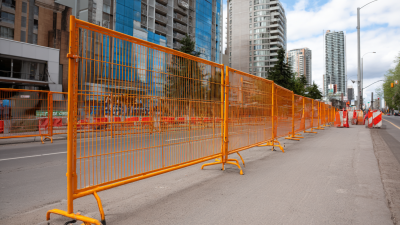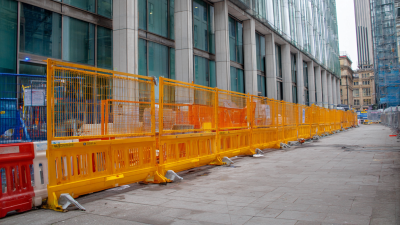Why Temporary Safety Fences Are Essential for Construction Site Security and Worker Safety
In the construction industry, ensuring the safety of both workers and the public is paramount.
Temporary safety fences have emerged as a critical component in enhancing security on construction sites.
According to a report by the Occupational Safety and Health Administration (OSHA), nearly 21% of construction site fatalities are attributed to falls, which can be mitigated through proper site management and temporary barriers.
Expert John Smith, a leading authority in construction safety measures, states, "Implementing temporary safety fences not only protects our workers but also secures the perimeter against unauthorized access, significantly reducing the risks of accidents."

Moreover, a study conducted by the National Institute for Occupational Safety and Health (NIOSH) found that the presence of temporary safety fencing reduces incidents of trespassing and vandalism, which can result in costly project delays.
As construction projects evolve and urban landscapes change, the demand for effective safety solutions like temporary safety fences becomes more pronounced.
The investment in these fences is not merely a regulatory compliance measure; it is a strategic approach to fostering a safer working environment.
By prioritizing temporary safety fencing, construction firms are paving the way for enhanced worker safety and operational efficiency.
Importance of Temporary Safety Fences for Worker Protection in Construction
Temporary safety fences are a crucial element in ensuring worker protection on construction sites. According to a report from the National Institute for Occupational Safety and Health (NIOSH), construction sites are among the most dangerous workplaces, with fall-related incidents accounting for over 40% of fatalities in the sector. Implementing effective barriers is essential not only for protecting workers but also for deterring unauthorized access which can lead to accidents.
Moreover, the Occupational Safety and Health Administration (OSHA) emphasizes that clear demarcation between construction zones and public areas is vital to maintain safety. Temporary safety fences serve as a physical reminder of the potential hazards present, helping to keep workers focused on their tasks while also minimizing distractions from external environments. Studies indicate that sites with properly installed safety fences see a 30% reduction in injury-related incidents, highlighting their importance in fostering a safer workplace atmosphere. The investment in temporary safety fencing is, therefore, both a financial and ethical necessity for any construction project aimed at ensuring worker safety and compliance with regulatory standards.
Key Benefits of Implementing Safety Fences at Construction Sites
Temporary safety fences play a critical role in enhancing security and safety at construction sites. One of the key benefits of implementing these fences is their ability to deter unauthorized access. By creating a visible barrier, safety fences prevent intruders from entering the site, thereby reducing the risk of theft, vandalism, and potential accidents. This added layer of security not only protects valuable equipment and materials but also minimizes liability for construction companies.
Moreover, safety fences contribute significantly to worker safety by clearly delineating hazardous areas. They help to reduce the risk of accidents by keeping pedestrians and unauthorized personnel away from dangerous work zones. By guiding foot traffic and preventing unexpected entry, these fences ensure that workers can perform their tasks in a protected environment. The presence of safety fences also aids in compliance with legal safety regulations, fostering a culture of safety and awareness on-site. Overall, the implementation of temporary safety fences is a crucial step in safeguarding both assets and people at construction sites.
Why Temporary Safety Fences Are Essential for Construction Site Security and Worker Safety
| Benefit |
Description |
Impact on Safety |
Implementation Cost |
| Perimeter Security |
Provides a physical barrier to unauthorized access |
Reduces risk of theft and vandalism |
$2,000 - $5,000 |
| Worker Protection |
Keeps workers safe from falling debris |
Decreases workplace injuries |
$1,500 - $3,000 |
| Regulatory Compliance |
Helps meet local and national safety regulations |
Avoids fines and legal issues |
$500 - $2,000 |
| Site Organization |
Clearly defines work zones and pathways |
Enhances workflow and reduces accidents |
$1,000 - $3,500 |
| Public Awareness |
Alerts the public to construction activities |
Improves community relations |
$300 - $800 |
Tips for Selecting the Right Type of Temporary Safety Fence
When selecting the right type of temporary safety fence for construction sites, it is crucial to consider factors such as durability, visibility, and the specific needs of the project. According to the Occupational Safety and Health Administration (OSHA), nearly 21% of construction site injuries are due to falls, making secure barriers an essential line of defense. Choosing a fence made from high-quality materials like PVC or steel can significantly enhance durability while providing clear visibility, helping to keep both workers and bystanders safe.
Additionally, the American National Standards Institute (ANSI) recommends that temporary fencing should be at least six feet high to effectively deter unauthorized access. When evaluating options, assess the intended use—fencing for active construction areas may require higher security, while fencing for public events may focus more on visibility and aesthetic appeal. It’s also advisable to consult local regulations, which may dictate specific requirements for construction site safety barriers, ensuring compliance and minimizing potential liabilities.
Best Practices for Installing and Maintaining Safety Fences
Temporary safety fences play a critical role in ensuring the security of construction sites and the safety of workers. Installing these fences requires adherence to best practices to maximize their effectiveness. Proper installation involves selecting appropriate materials that can withstand environmental factors while preventing unauthorized access. Regular inspections and maintenance are essential to ensure that the fences remain intact and secure. This proactive approach not only minimizes risks but also enhances compliance with safety regulations.
As the global electric fencing market is projected to grow from $362.4 million in 2025 to $618.5 million by 2032, there is a clear trend towards investing in advanced security solutions for construction sites. Technologies, such as robust monitoring software that incorporates 3D surveillance capabilities, allow for more effective management of site safety. Innovations like these demonstrate the industry's commitment to harnessing technology to protect both workers and valuable assets. Integrating these advanced security measures underscores the importance of maintaining a safe working environment in the ever-evolving construction landscape.
Legal Requirements and Standards for Construction Site Safety Fences
Temporary safety fences play a crucial role in ensuring compliance with legal requirements for construction site safety. Various regulations outline the necessary standards to protect both workers and the public. In many jurisdictions, these fences are mandated to delineate the construction area, preventing unauthorized access and reducing the risk of accidents. Compliance with such laws not only emphasizes the importance of safety but also reflects a commitment to maintaining community well-being during construction activities.
Specific regulations often detail the height, design, and materials used for safety fences, ensuring they meet safety and aesthetic standards while effectively securing the site. For instance, local rules may stipulate certain structural features that enhance visibility and stability, which are vital for protecting workers from potential hazards, such as falling debris or equipment. By adhering to these guidelines, construction companies demonstrate their proactive approach to worker safety and legal compliance, ultimately fostering a safer working environment that aligns with industry best practices.

Home
About Us
Products
Customize
Application
Support
Blog
Contact Us






